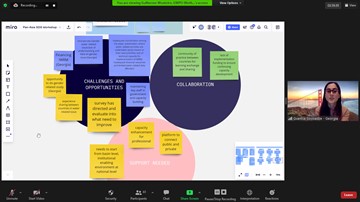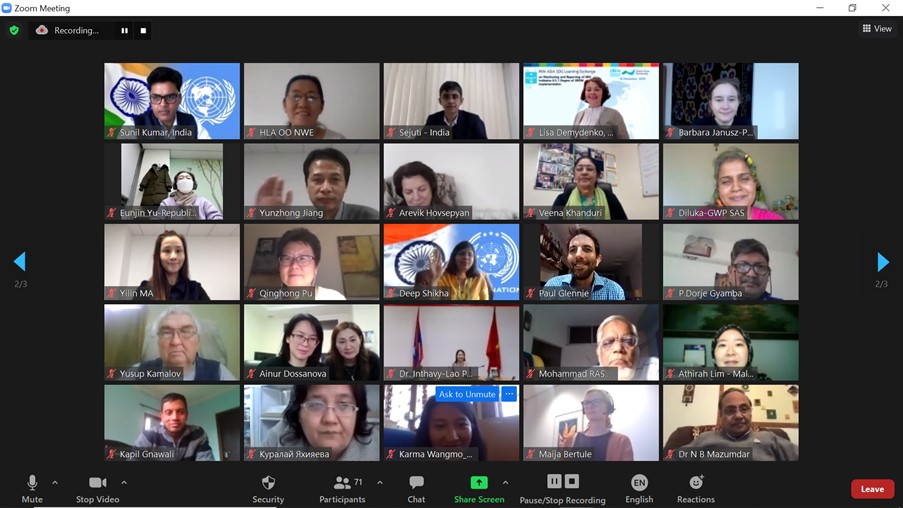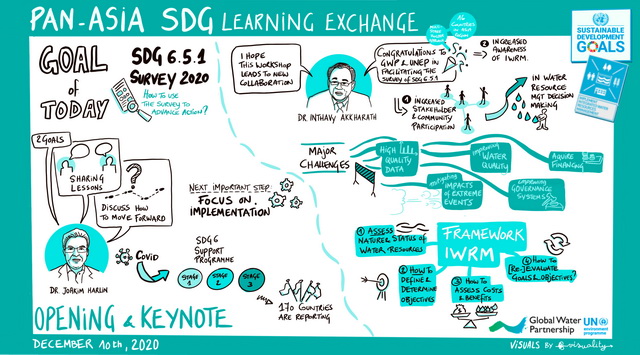The event successfully obtained several objectives, in particular:
- Highlighted good practices and challenges in completing the 6.5.1 questionnaire in the round 2020 survey.
- Identified any possible adjustments that need to be incorporated in the next round of the survey.
- Identified common challenges and opportunities to advance on IWRM that had been identified through the survey; and establish collaboration at the PAN-Asia level to move forward together.
The online workshop on 10 December 2020 started with opening remarks from Dr. Joakim Harlin, Head of Freshwater Unit of UN Environment and the UNEP-DHI Centre on Water & Environment. He highlighted to date 170 countries that have reported on the status of their IWRM implementation 2020 and currently financially and technically assisted 61 countries in reporting the SDG 6.5.1 as well as providing technical support to at least 9 other countries. According to the 2017 baseline report, 80% of countries in the Asia Pacific have laid the foundations for IWRM, which at least have reached the medium-low level of implementation. He also stressed the opportunities for peer learning to support the weaker countries as shown by the 2017 baseline report.
The opening continued with a keynote speech from the GWP-SEA Chairman who also the chair of the ASEAN Working Group on Water Resources Management, Dr. Inthavy Akkharath. He presented, “To some extent, many countries are in the fortunate position that water resources availability is not a major limiting factor in terms of economic growth. However, other countries do face a number of significant challenges and issues in the years ahead. In Southeast Asia, it would appear that major challenges include collection of high quality data, mitigating the impacts of extreme events on water resources, sustaining and improving water quality, improving governance systems and acquiring financing for the development of new water infrastructure.”
After a short break through an ice-breaking session, the workshop continued with the plenary session. The key aspects of the survey/consultation process, challenges met, best practices, and lessons learned in reporting on SDG 6.5.1 were presented by 4 country representatives from Bangladesh, Uzbekistan, Malaysia, and China. Their experiences were then furthermore discussed in the panel discussions a break-out group session.
The break-out group consists of two session, focused on the challenges & opportunities, collaboration, and support needed in relation to the next round survey, the advancement of the IWRM, and the possible collaboration at the Asia Pacific. In between the group discussion, two-panel discussions were carried out.

Picture 1. Ms. Gvantsa Sivsivadze, participant from Georgia presented the result from her group discussion
The first panel discussed the reflection on the implementation of the SDG 6.5.1 survey process in 2020, lead by Mr. Colin Herron, the Global Coordinator Water Solutions for the SDG at GWP Organization, and Mr. Thomas Panella, Chief of Water Sector Group at the Asian Development Bank.
The second-panel discussion lead by Prof. Victor Dukhovny, the Director of Scientific Information Center Water Commission (ICWC), and Mr. Ravi Narayanan, Chair of Governing Council, the Asia Pacific Water Forum (APWF).This session focus on advancing the IWRM towards the achievement of the SDG.
In the group discussion, the challenges were pinpointed as follows:
- Related to the use of words and technical terminologies that participants were not familiar with or did not understand. This was viewed as leading to confusion or need for further explanation and clarification of survey questions and threshold descriptions.
- Related to the use of words with multidimensional aspects or dimensions like capacity, management instruments, and participation.
- Participants difficulty in “understanding issues presented in the survey instrument”. Respondents from two countries in Central Asia perceived that the questionnaire was not context-sensitive and was not aligned with the on-ground realities of all participating countries
- Related to the framing of some of the survey questions. Respondents reported that some questions are unclear, confusing, open to varied interpretations, or were considered as overlapping with another related or closely linked question.
- Related to the suitability of threshold descriptions for all countries/settings. The standard/fixed descriptions of thresholds were viewed as not context-sensitive or appropriate to the actual realities and conditions of all countries.
- On the justification narrative, (i.e., evidence and supporting data). The absence of clear-cut guidelines on the number of words required or desired length of the discussion made it difficult to ascertain the necessary and sufficient level of detail for this part of each question/section.
- Related to value and use of the footnotes provided.

Picture 2. Participants of the PAN-ASIA SDG Online Learning Exchange
In view of all these aforementioned instrument related challenges, some participants recommended that the questionnaire be reviewed and improved; a few others suggested that it be modified and simplified. Another noteworthy recommendation is to provide countries with the necessary background on how the survey instrument was developed, its rationale, and the reasoning behind the metrics used. AW, CVA.
Find out more about the events material through this URL
